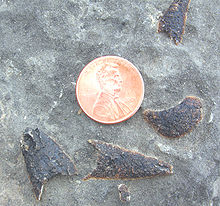Matthevia
Appearance
| Matthevia Temporal range:
| |
|---|---|

| |
| Plates of Matthevia. Coin: 19 mm diameter | |
| Scientific classification | |
| Domain: | Eukaryota |
| Kingdom: | Animalia |
| Phylum: | Mollusca |
| Class: | Polyplacophora |
| Order: | †Paleoloricata |
| Family: | †Mattheviidae |
| Genus: | †Matthevia Walcott, 1885 |
Matthevia is a Cambrian mollusc, perhaps related to the chitons.[3] It consists of repeated monoplacophoran-like shells; according to one hypothesis, chitons arose when these tall shells began to overlap over the generations. The tall element of the shell was retained and forms the tips of modern chiton plates.[3] There are distinct head, 'centre', and tail valves, which occur approximately in the ratio 1:5:1 — suggesting a seven-plated configuration.[4]
References
- ^ ), Geological Survey (U.S. Geological Survey professional paper.
{{cite book}}:|author1=has numeric name (help) - ^ Pojeta, J.; Taylor, J. F.; Darrough, G. U. Y. (2005). "Matthevia (Polyplacophora) Invades the Ordovician: The First Reported Post-Cambrian Occurrence". Journal of Paleontology. 79 (5): 1021. doi:10.1666/0022-3360(2005)079[1021:MPITOT]2.0.CO;2.
- ^ a b Runnegar, B.; Pojeta Jr, J. (Oct 1974). "Molluscan Phylogeny: the Paleontological Viewpoint". Science. 186 (4161): 311–317. Bibcode:1974Sci...186..311R. doi:10.1126/science.186.4161.311. JSTOR 1739764. PMID 17839855.
- ^ Runnegar, B.; Pojeta, J.; Taylor, M. E.; Collins, D. (1979). "New Species of the Cambrian and Ordovician Chitons Matthevia and Chelodes from Wisconsin and Queensland: Evidence for the Early History of Polyplacophoran Mollusks". Journal of Paleontology. 53 (6): 1374–1394.
